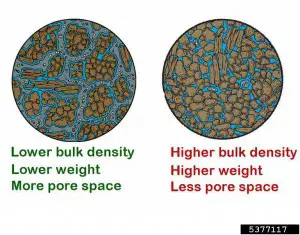Bulk density of aggregates is the mass of aggregates required to fill the container of a unit volume after aggregates are batched based on volume.
It depends on the packing of aggregate i.e. Either loosely packed aggregates or well dense compacted aggregates. In case, if the specific gravity of material is known, then it depends on the shape and size of particles. It is because, if all the particles are of same size than packing can be done up to a very limited extent. If the addition of smaller particles is possible within the voids of larger particles than these smaller particles enhance the bulk density of the packed material. Shape of the particles also influence very widely, because closeness particles depends on the shape of aggregates.
If a statement is like: A coarse aggregates with higher bulk density, then it means few of the voids can be filled by using fine aggregates and cement. For testing, British Standard (BS 812) has specified the degree of compaction. These are;
- Loose ( Un-compacted)
- Compacted
The test will be carried out by using metal cylinder having prescribed depth and diameter and the bulk density is to be determined depending on the maximum size of aggregates and the degree of compaction.
Loose Bulk Density
Loose bulk density can be determined by filling the container with dried aggregates until it overflows from the container. Now level the top surface of container by rolling a rod on it. After that, weight the aggregate mass that is inside the container and divide it by the volume of container. This will give you the bulk density of the loose aggregates.
Compacted Bulk Density
Compacted bulk density can be determined by filling the container in three layers and tamped each layer with a 16mm diameter rounded nosed rod. After filling in three layers, now leveled the top surface and evaluate compacted bulk density by using the same expression as for loose bulk density.
Weight the aggregates mass that are inside the container and divide it by the volume of the container”. This will give you the bulk density of compacted aggregates.
